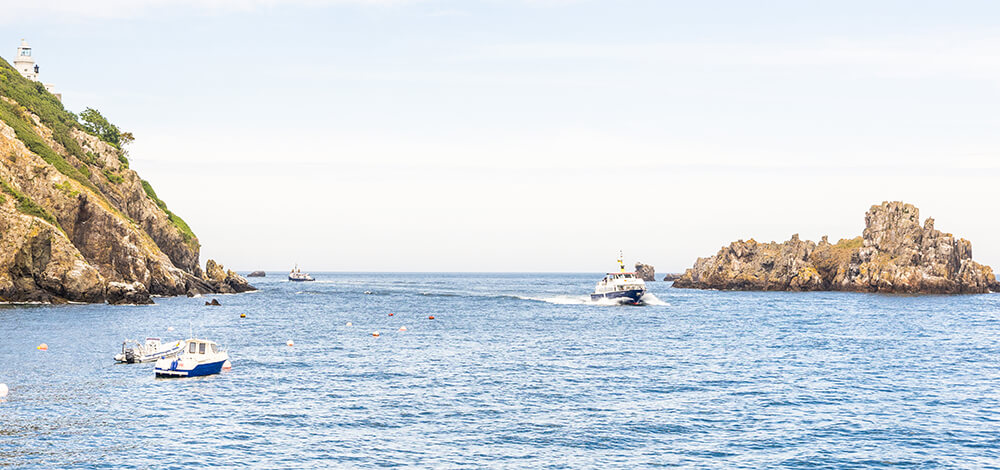
In the Channel Islands, nestled between The UK and France, the Island of Sark is a small, charming island measuring just under 5 kilometers long and 1.6 kilometers wide. The small island has a population of around 600 people living a secluded but fulfilling life on this beautiful island.
Sark, in addition to its wonderful charm and serene setting, is home to the world’s smallest prison, still in use today. The Sark Prison doesn’t get a lot of inmates these days, but it does serve as the island jail for locals or out-of-control tourists on rare occasions.
The History of Sark Prison
The small island has a fascinating and rich history of conflict before finally settling into the charming, calm setting it delivers for locals and tourists today. The island of Sark first appeared in text in the 11th century when it was given as a gift to Mont-Saint-Michel Abbey from William of Normandy. Later the French captured the island in the 16th century, followed by the English later on. The island often was a site for smugglers and pirates throughout history. During WWII, the Germans occupied the island as a part of the sea defense against the Nazis.
After the war, the island settled into a rustic feel with old-world charm. There are no cars, streetlights, or roads on the island and no airports. The island is accessible by boat only. The only way to get around is by walking, biking, horse-drawn carriage, or by horseback. It’s one of the only places in the world where emergency vehicles are pulled by tractors or horses.
The Sark Prison that stands today was not the original prison. The first prison was built to defend the island against invasion soon after the defeat of the Spanish Armada in 1588. It was necessary to create a place to hold captives and enemy prisoners. During these times, there was one porter or jailer on the island to guard and manage the prisoners and prevent escape.
Life on the island, when trouble occurred, mostly ended with the accused in the stocks rather than in a jail cell. The stocks would subject the prisoners to public ridicule, where they would throw objects such as food or rocks from dawn to dusk. Other forms of punishment delivered would be to sit on the Penance Bench sentenced by the Island Consistory Court made up of elders of the Presbyterian Church.
When prisoners were sentenced to time in the cells or for holding, they were only allowed to be held for two days maximum, as deemed by the judicial system in the 16th century. If the crime was more severe, the prisoners were sent to the Guernsey prison and court system.
In the early 1800s, the original prison, which was located across from the church, was deemed unfit. The undercroft of the Arsenal was used as an interim prison until the new prison was built. The undercroft of the Arsenal was not very secure, with one window without bars which made for an easy way to escape. The Guernsey Courts ordered a new prison to be built in 1832, but due to budgetary constraints, it took over 20 years to begin the construction of a new prison.
The Sark Prison was built in 1856 with only two cells and fitted with an iconic barrel roof and no windows. The adjoining cells held a maximum of two prisoners, with one measuring 6 feet by 6 feet and the other at 6 feet by 8 feet. The cells are separated by a long narrow walkway stretching the length of the building. Inside the cells are small wood-slatted beds with a thin mattress for inmates to rest.
The One-Man Invasion of Sark
It’s impossible to mention the Sark Prison without mentioning one of the most infamous criminals, and crimes attempted in 1990. Andres Gardes, a nuclear physicist who at them was unemployed, believed he was the rightful heir and Seigneur of Sark island. He decided to take action and invade the island by himself.
Gardes arrived on the island the day before his planned invasion and posted notices on the island of his plan, including when and where. The Constable, the only law enforcement on the island, was prepared to manage the situation thanks to the posted notices.
On the second day, armed with a semi-automatic rifle, he began his invasion but was swiftly met by the Constable, who proceeded to punch him in the face, effectively and quickly ending the conflict. Andres Gardes was arrested, and the invasion was thwarted. The gun Gardes used can be viewed in the Sark Museum today.
Crime on Sark Today
With such a small population and home to true locally-owned restaurants and shops, the island has relatively minimal crime today. Sark still follows the judicial rules set in a place where serious offenses are shipped to the neighboring Guernsey Island to be given a fair trial and serve out their sentence. The Sark Prison doesn’t have a lot of visitors or inmates aside from the occasional tourist or worker who may get out of hand due to a little too much to drink.
The police force on the island is minimal, with a Constable and a Vingtenier, also called the Constable’s assistant. A Deputy Constable is on staff as a permanent fixture in the prison to help with paperwork and manage the smaller details of the prison. The elections on the island are simple, with a Vingtenier elected every year. Once the year is completed, the Vigntenier becomes the new Constable, and a new Vingtenier is elected. The Sark Prison is located right next to the visitor center in the center of the island.
 Explore on map
Explore on map Back
Back